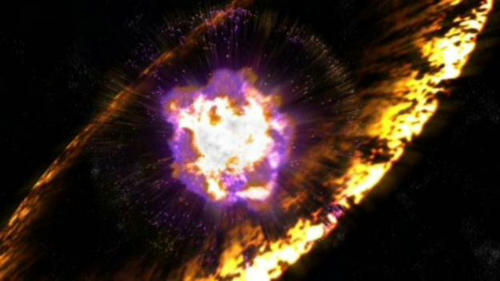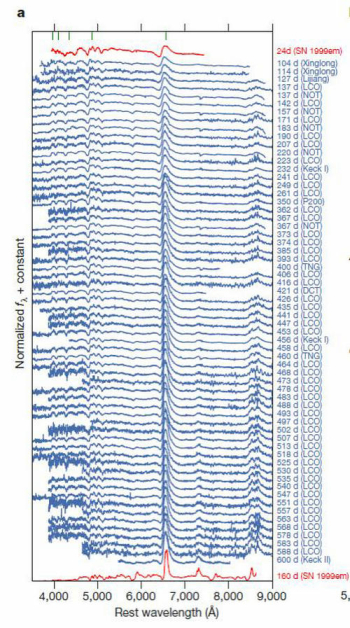
A supernova is a transient astronomical event that occurs when a massive star approaches the end of its evolution, whose dramatic and catastrophic destruction is marked by one final titanic explosion. During this time, a supernova radiates energy comparable to the sum of the sun's radiant energy throughout its lifetime.
Scientists have observed the supernova iPTF14hls with the most violent explosion in a strangest form through the 2.16-meter telescope at Xinglong Observation Base of National Astronomical Observatories,Chinese Academy of Sciences (NAOC). The research results have been published on Nature recently.

Artistic conception of supernova explosion (Image by Greg Stewart, SLAC)
It was first identified as a hydrogen-rich nuclear collapse supernova, which generated five consecutive large-scale energy releases (see Figure 2) in about 600 days after explosion, with total burst energy a hundred times that of a normal supernova.

The supernova iPTF14hls grew bright and dark at least five times over two years. Such behavior has never been observed before; supernovas usually stay bright for about 100 days and then disappear. (Image by LCO/S. Wilkinson.)
In observation and research of the supernova, the 2.16-meter telescope and the 80-centimeter TNT telescope (Tsinghua University-National Astronomical Observatory telescope) at Xinglong Observation Base respectively contributed the first two spectra (see Figure 3) and a multi-color photometry data.

Spectral evolution sequence of supernova iPTF14hls. Blue is the complete spectrum of supernova iPTF14hls and red is the spectrum of the type II-P supernova SN 1999e for comparison. The abscissa is the lab stationary wavelength, and the ordinate on the right indicates the number of corresponding days and telescopes being used (the "Xinglong" is corresponding to the 2.16-meter telescope at Xinglong Observation Base) after the explosion of supernova iPTF14hls. The 2.16-meter telescope contributes the first two spectra of the spectrum. (Image by WANG Xiaofeng and ZHANG Tianmeng)
The 2.16-meter telescope is a self-developed two-meter optical telescope in China, with fruitful scientific research results after being put into use in 1989. Since 2011, the telescope has obtained spectral data of various types of supernova, identifying the spectral type of nearly 100 newly explored supernovas, with accumulation of nearly 700 pieces of supernova spectral data.
These spectral data, combined with the photometric data from the 80-centimeter telescope provided important constraints on the understanding of various types of supernovae, precursor stars and stellar evolution physics. These data will be released within one-two years and are expected to have a significant impact in the field of supernova research.
This research result was jointly completed by an international cooperation team. The Chinese team is led by Professor WANG Xiaofeng of Tsinghua University and ZHANG Tianmeng, an associate researcher of the National Astronomical Observatory.

86-10-68597521 (day)
86-10-68597289 (night)

86-10-68511095 (day)
86-10-68512458 (night)

cas_en@cas.cn

52 Sanlihe Rd., Xicheng District,
Beijing, China (100864)

